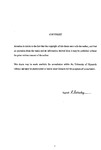SEAWATER pH AND THE OCEANIC CARBON CYCLE
| dc.contributor.author | BELLERBY, RICHARD GARTH JAMES | |
| dc.contributor.other | School of Biological and Marine Sciences | en_US |
| dc.date.accessioned | 2011-09-22T13:46:04Z | |
| dc.date.available | 2011-09-22T13:46:04Z | |
| dc.date.issued | 1994 | |
| dc.identifier | Not available | en_US |
| dc.identifier.uri | http://hdl.handle.net/10026.1/609 | |
| dc.description | Merged with duplicate record 10026.1/2089 on 06.20.2017 by CS (TIS) | |
| dc.description.abstract |
The buffering of carbon dioxide in seawater and the intimate relationship between the carbonate system, air-sea gas exchange and biological productivity in the oceans is described. Characterisation of the carbonate system is enabled through the concurrent measurement of any two of the variables pH, alkalinity, TCO2 and pCO2. It is identified that to obtain the high density, high precision measurements necessary to better constrain carbon cycle models, with respect to estimating the effect of anthropogenic carbon release to the atmosphere, it will be necessary to develop in situ techniques for the measurement of pH and pCO2. The theory of pH scales and both potentiometric and spectrophotometric pH measurement is presented as well as a chronology of pH measurements at sea. The development of automated potentiometric and spectrophotometric techniques for the simultaneous, continuous, shipboard determination of seawater pH is documented and the performance of the instrumentation on a cruise to the Southern Ocean is reported. The potentiometric system was optimised for electrode response and incorporated increased temperature control and a novel flow cell to help reduce bubble effects and maintain the integrity of the liquid junction. Nevertheless, the technique illustrated very erratic potential and the data was of unacceptable quality. The spectrophotometric technique used a flow injection technique and phenol red indicator and showed a precision off 0.005 pH unit with a sampling frequency of about 25 h-1. A comparison of calculated alkalinity from the combinations pH and pCO2 and pCO, and TCO. 2 had a residual of 1.3 17.3 4equiv. kg-1 (n = 79) or about 0.32 %. The theoretical precision of the comparison calculated from the precisions of the methods used is 0.34 %. A comparison of in situ pH and that calculated from alkalinity and TCO2 showed a standard deviation of ± 0.016 with a standard error dependent on the choice of sulphate formation constant used to convert from the free to the total hydrogen ion concentration scale. Surface pH(SWS) at 25°C has been shown to vary significantly in the Southern Ocean from 7.65 in the Bransfield Strait to 7.85 in a area of intense biological activity associated with the South Polar Front (SPF). Throughout the majority of the cruise the surface waters were undersaturated with respect to carbon dioxide and the main control on pH was from the hydrography, although in areas of high chlorophyll concentrations, associated predominantly with the SPF, there existed considerable correspondence with biological activity. A previously unknown sink for atmospheric CO2 has been identified in the Bellingshausen Sea which has significant implications for our understanding of the global carbon budget. The spectrophotometric method is put forward as the method of choice for future measurements of seawater pH. | en_US |
| dc.description.sponsorship | Plymouth Marine Laboratory | |
| dc.language.iso | en | en_US |
| dc.publisher | University of Plymouth | en_US |
| dc.title | SEAWATER pH AND THE OCEANIC CARBON CYCLE | en_US |
| dc.type | Thesis | |
| plymouth.version | Full version | |
| dc.identifier.doi | http://dx.doi.org/10.24382/3388 | |
| dc.identifier.doi | http://dx.doi.org/10.24382/3388 |
Files in this item
This item appears in the following Collection(s)
-
01 Research Theses Main Collection
Research Theses Main



